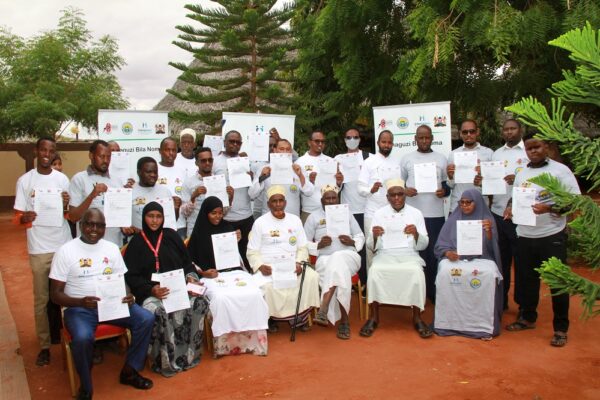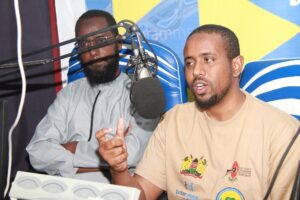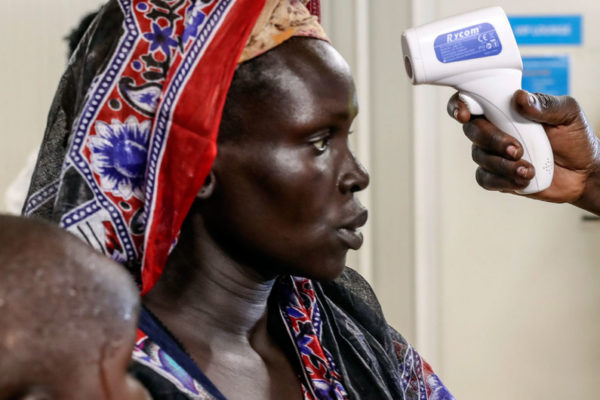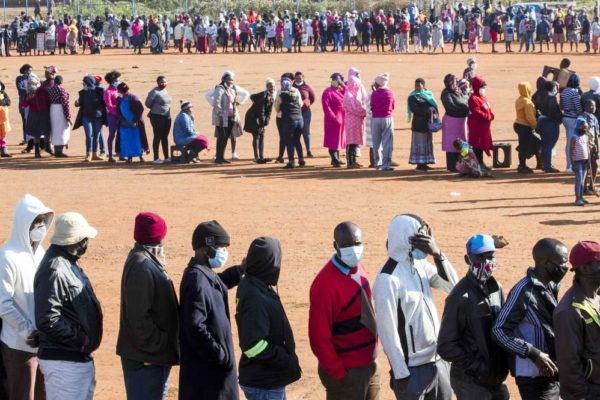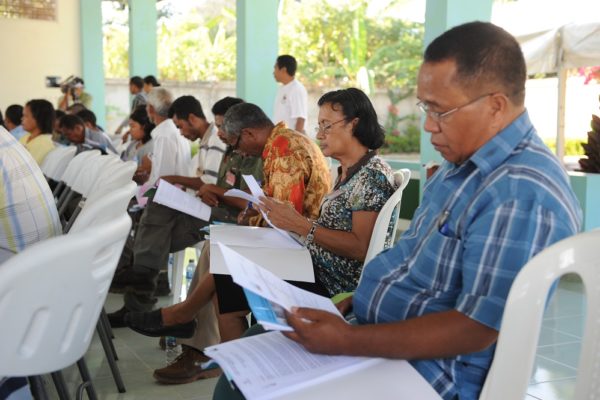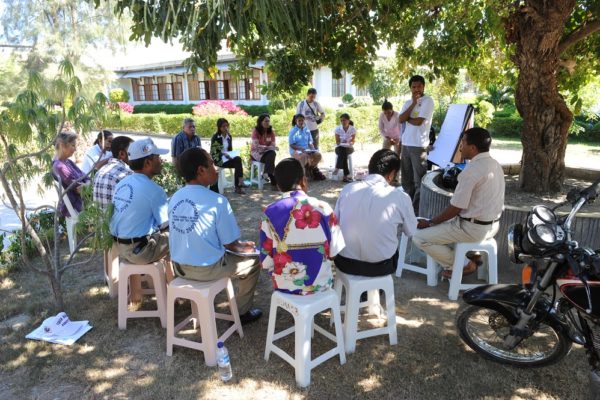Prévention de la violence électorale par l'alerte précoce et la réponse rapide au Kenya
"Peace is such a fragile product that you can spend years nurturing it, only for it to be brought down overnight like a building demolished by excavators. You can only wake up to the debris. If there is a time when such a thing is susceptible to occur, it's during the general elections held every five years in our country." Mohamed Harun, County Chief Officer, Youth Affairs, County Government of Mandera.
In the past, there has been a lot of violence during elections, which has caused the loss of lives, displaced many Kenyans, destroyed property, and led to loss of livelihoods. “Communities turn their backs on each other; voters are transported in mass from one place to a different place to vote for 'their person'; the elderly are dethroned and dehorned, and all the functioning structures of the communities are suspended. Unfortunately, this often leads to evil people in our midst taking advantage of such a situation by starting conflicts,” observes Harun.
These polling-related incidents are oftentimes an expression of existing and overlapping conflicts, which are frequently influenced by past skirmishes whose wounds haven't healed. In turn, the drivers of these various conflicts are linked to Kenya's deep and persistent fault lines, themselves related to historical, socio-political marginalization and grievances and elite manipulation of identities for political mobilization. However, the collaborative efforts by various peacebuilding actors have played a key role in mitigating skirmishes to address the drivers of violent conflict and strengthen social resilience for peace.
Le 9th les Kényans se sont rendus aux urnes et ont voté de manière largement pacifique. Le 15th août 2022, William Samoei Ruto, chef de l'Ordre du Cœur d'Or (C.G.H.), a été annoncé comme président élu. Il n'y a pas eu de violence électorale à grande échelle, malgré un scrutin très contesté, de fortes tensions au centre de dépouillement et la contestation judiciaire subséquente par le vétéran Raila Odinga et sa coalition Azimio La Umoja. Des incidents isolés ont été observés. Le scrutin a été suspendu dans la circonscription d'Eldas, dans le comté de Wajir, pour des raisons de sécurité, après un échange de coups de feu qui a interrompu le transport des bulletins de vote. Les divergences politiques dans des comtés comme Lodwar Town et West Pokot ont été associées à des combats et à des affrontements publics, la région du Rift Nord ayant connu des tensions et des violences lors des élections précédentes.
La conclusion largement pacifique des élections est un grand succès résultant d'énormes efforts des autorités kényanes, de la société civile et des partenaires internationaux. Appuyés par le ministère fédéral allemand des Affaires étrangères, Interpeace et ses partenaires, la National Cohesion and Commission (NCIC) et le Réseau pour la paix, la cohésion et le patrimoine (NEPCOH) ont soutenu les acteurs du pays dans leurs efforts pour construire la paix et prévenir les conflits violents grâce à leur projet de prévention de la violence électorale dans plusieurs régions. Actif dans les comtés de Mandera, Wajir, Turkana, West Pokot, Elgeyo Marakwet, Baringo, Samburu et Laikipia, le projet en cours se concentre sur l'établissement d'un mécanisme d'alerte précoce et de réponse rapide et sur la sensibilisation à la paix du public et des acteurs électoraux.
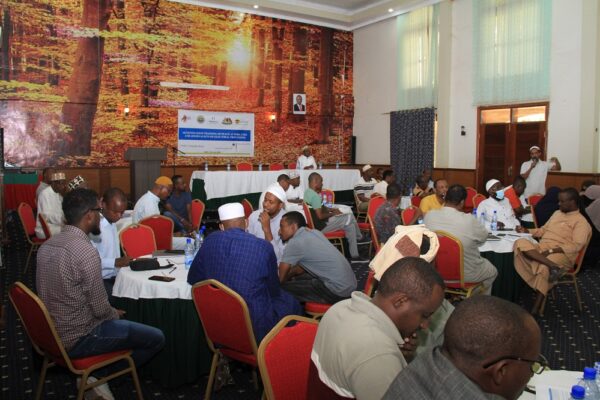
Alerte précoce et réponse rapide aux incidents liés aux élections
Ces structures ont été établies dans tous les comtés couverts par le projet et leurs membres ont été formés aux processus électoraux, à la médiation et à la consolidation de la paix, ce qui a renforcé leur capacité à prévenir, atténuer et gérer la violence électorale. Au total, 106 observateurs des élections et de la cohésion ont été déployés dans tous les sous-comtés, recueillant en permanence des informations et les transmettant à trois salles de situation. Créées spécialement pour la période électorale, celles-ci ont traité tous les rapports venant du terrain et les ont transmis à une unité intégrée d'orientation et de réponse, composée de fonctionnaires, d'agences de sécurité, de leaders de la société civile et de membres des infrastructures de paix locales, pour des actions de suivi.
Malgré le caractère globalement pacifique des élections, 21 incidents ont été relevés par les mécanismes d'alerte précoce et de réponse rapide. Le projet a permis une réaction à dix d'entre eux, tandis que tous les autres continuent à faire l'objet d'un suivi. Par exemple, dans la ville de Konton, à la frontière des comtés de Wajir et de Mandera, un conflit entre deux clans somaliens, les Garre et les Degodia, a éclaté le 6 août, faisant un mort et cinq blessés. En raison des campagnes pour le poste de gouverneur dans les deux comtés et d'une histoire d'affrontements intercommunautaires entre les deux groupes, certains redoutaient que les élections à venir ne conduisent à une escalade de la violence. Cependant, les infrastructures de paix locales établies lors de la phase précédente ont pu servir de médiateur au conflit avec le soutien du projet. Tout d'abord, les communautés ont accepté d'ajourner leurs différends jusqu'à ce que les tensions liées aux élections s'apaisent. L'infrastructure de paix a ensuite facilité la conclusion d'un accord prévoyant le versement de compensations et la présentation d'excuses officielles, amorçant ainsi un processus de réconciliation entre les deux groupes.
Des réunions ont été organisées pour préparer la communauté aux élections et pour former des observateurs électoraux, qui ont aidé à garder un œil sur les violences politiques éventuelles. Pendant la campagne, les comités de surveillance du cessez-le-feu (CMC) du comté ont été utilisés pour mettre en place un système d'alerte précoce des conflits et un système de réponse rapide. L'importance des infrastructures locales de consolidation de la paix, lors des élections et au-delà, a été soulignée par diverses parties prenantes. S'exprimant lors d'une session de formation, le chef Biashar, président d’un CMC, a souligné la nécessité de s'appuyer sur les structures de paix.
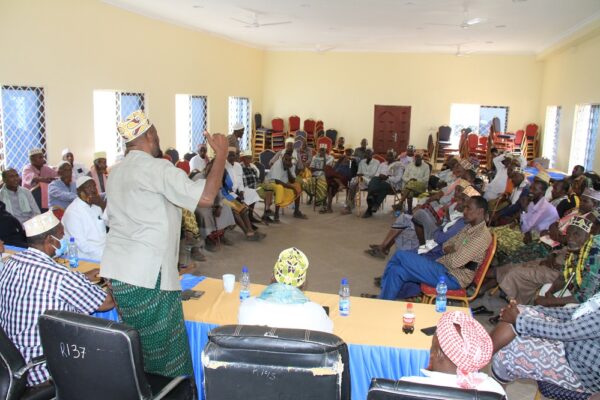
"We talk of addressing development in our communities, yet we overlook peace and its importance. What kind of development can we achieve without peace? I would suggest we focus all our energies and resources on building peace structures like CMCs and making them a fully functional peacebuilding body of their own, rather than investing resources in other unimportant development projects by our government. Peace should be prioritized above all. Once consensus is established, and its structures are in place, we can only discuss development.: said Chief , Ceasefire Monitoring Committees Chairman, Banisa
Formation et plaidoyer pour des élections pacifiques
À l'approche des élections, le NCIC, NEPCOH et Interpeace ont planifié et coordonné des ateliers de sensibilisation, diffusé des messages de paix dans les zones locales à l'aide de matériel de marque, organisé des caravanes de la paix et incité les candidats politiques à signer des chartes de la paix. Tous ces efforts visaient à susciter et à maintenir l'engagement des parties prenantes à tous les niveaux de la société en faveur d'élections pacifiques.
Dans les comtés de Mandera et de Wajir, de nombreuses parties prenantes, dont les médias locaux et les jeunes, ont été formées sur des sujets tels que les messages en faveur de la paix autour du slogan Elections Bila Noma (Elections sans problèmes) les reportages sensibles aux conflits, la gestion des discours de haine et les mécanismes alternatifs de résolution des conflits électoraux (EADR).
À la suite des années précédentes où des opérateurs de"boda boda" (motos) ont provoqué des escarmouches dans les centres urbains, une tournée de promotion de la paix a été organisée à Kapenguria et à Pokot Ouest sur le thème "Elections Bila Noma". Hussein Yussuf, le responsable du département de la gestion des conflits, de la cohésion et de l'intégration de Mandera, a parlé de la nécessité de la paix pendant la période électorale lors d'un roadshow à Mandera.Elections Bila Noma’ theme was organized. Hussein Yussuf, the Mandera Chief Officer for the Department of Conflict Management, Cohesion, and Integration talked about the need for peace during the election period during a road show in Mandera.
"Peace is a very vital organ in our community. Like the heart organ in the body, peace is the kernel of our existence. Without it, all the other aspects of our lives are doomed! We must work extra hard during this electioneering period to make sure our communities will have peaceful elections and smooth transition of power to the new administrations," said Mr Hussein.
En donnant la priorité à la paix pour tous et en construisant des structures pour maintenir la stabilité, il est nécessaire de mettre l'accent sur les jeunes, les femmes et les groupes marginalisés pour assurer la viabilité et la durabilité. Afin de prévenir, d'atténuer et de gérer efficacement la violence et les différends électoraux, et de réduire les risques d'escalade, les femmes ont donc été spécifiquement ciblées dans divers éléments de formation et d'engagement. Par exemple, elles ont souvent été appelées à participer à de nombreuses émissions de radio en tant que leaders d'opinion.
En outre, des journées de prière dans les comtés, réunissant des chefs religieux et des candidats politiques, ont été organisées. Afin de tenir les dirigeants responsables de leur conduite pendant les élections générales, les candidats politiques, les commissaires de comté et les représentants des acteurs de la paix ont signé des chartes de paix dans tout le pays. Le chef Abey, membre du CMC de Banisa, a souligné l'importance des efforts de collaboration pour la consolidation de la paix en déclarant : « Les périodes électorales ont toujours été synonymes de malheur pour notre peuple, en particulier le long du corridor Mandera Nord-Banisa, en raison des souvenirs du passé que les élections font resurgir. Nous avons perdu des vies, des biens et des moyens de subsistance lors des élections en raison des conflits claniques permanents entre Garre et Degodia qui vivent le long de ce corridor ». « Bien que cette élection ne concerne que la politique du parti et l'intérêt individuel plutôt que les affaires claniques, nous prions pour que ce que nous avons connu dans le passé ne se répète pas. Notre comté et ses habitants s'épanouiront lorsque nous donnerons la priorité à la paix sur tout», dit-il.
In Kenya, the focus of Interpeace’s work historically has been on peacebuilding at the community level in the north-eastern part of the country (Mandera and Wajir Counties) and, more recently, the North Rift Region. Its efforts to build peace are aimed at fostering equitable solutions to share power and resources; increasing and maintaining social cohesion among communities with long-standing and ongoing grievances; improving trust and cooperation between security actors and Kenya's public and helping to create new opportunities as ways to keep peace in Kenya after the elections.
